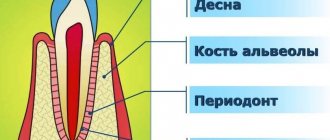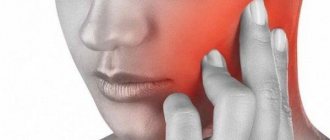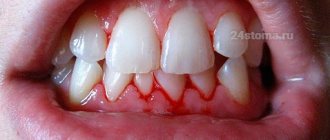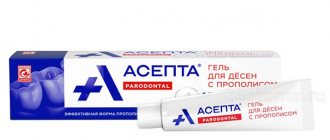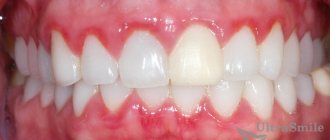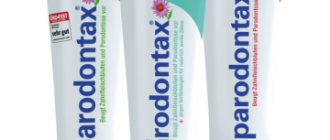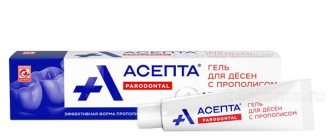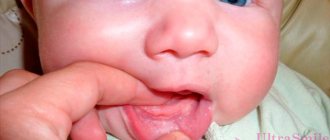From this article you will learn:
- what are gum diseases,
- how do they differ from each other,
- treatment and symptoms of gum disease in adults.
The article was written by a dentist with more than 19 years of experience.
Gum disease is a whole group of diseases, among which the most common are “gingivitis” and “periodontitis”, and much less frequently are diseases such as periodontal disease. The latter term is known to everyone, but in most cases patients use it incorrectly, using it to refer to inflammation of the gums. Although real “periodontal disease” occurs without inflammation at all and is only a degenerative gum disease.
In professional language, gum disease is usually called “periodontal disease,” and dentists who specialize in the treatment of this pathology are proudly called periodontists. Therefore, if you have one of the gum diseases, we recommend that you contact periodontists for advice and treatment, and not regular dental therapists. The same applies to regular removal of dental plaque.
What is periodontium (periodontal disease) –
This is a complex of tissues surrounding the tooth, which includes - 1) the gums around the tooth, which is part of the mucous membrane of the oral cavity, 2) periodontium - the ligamentous apparatus due to which the tooth is attached to the bone, 3) the bone tissue around the tooth. In accordance with the fact that various gum diseases are accompanied by inflammation and/or destruction of the constituent parts of the periodontium, these diseases are called the specific term “periodontal diseases”.
In addition to gingivitis, periodontitis and periodontal disease, periodontal diseases include 2 more groups of diseases. Firstly, quite rare “idiopathic periodontal diseases” (these include desmontosis, histocytosis-X and Papillon-Lefevre syndrome). Secondly, these are benign tumor-like formations, called “periodontomas”. These include, for example, diseases such as gingival fibromatosis, epulis and periodontal cysts.
Why do you need to start treating your gums?
Inflammation of the gums is a process triggered by the active proliferation of bacteria.
Microorganisms that colonize in the oral cavity happily feed on food debris on the teeth and gums. The result of their active life is a soft plaque, which over time turns into hard plaque (tartar is formed). The gums become inflamed and weak.
Few people think that the tooth and gums influence each other with equal force, but they are anatomically connected. Periodontal disease can even cause the loss of a healthy tooth.
The periodontium is a complex of tissues consisting of the gums, alveolar process, root cementum, and periodontium (ligaments that hold the tooth in bone tissue). If changes occur in one of the components of the periodontium, this will affect the general condition of the adjacent tissues.
In terms of prevalence, gum disease seriously competes with caries. And diseases most often arise as a result of negligence in the most ordinary oral hygiene. Teeth are brushed incorrectly or irregularly.
Important for patients with cardiovascular pathology -
Many patients with gum inflammation try to self-treat, which involves regular use of antiseptics. Antiseptic solutions are not able to completely “disinfect” dental deposits (consisting of pathogenic bacteria) - to their entire depth, because antiseptics affect only the most superficial layer of microbial plaque or tartar. Therefore, firstly, the pathogenic effect of bacteria will continue even against the background of antiseptic rinses. But this is not the most dangerous thing.
Scientific research has shown that antiseptics interfere with the ability of oral bacteria to convert nitrates (found in foods) into nitrites. This bacterial activity is called “nitrate-reducing” and is one of the mechanisms that regulates our blood pressure. The fact is that nitrites formed by bacteria are then absorbed into the blood, and they help lower blood pressure. Therefore, if you regularly use antiseptic products (even toothpastes), this will reduce the production of nitrites by oral bacteria and may cause an increase in blood pressure.
This may not be noticeable in young healthy people, but will be significant in patients with chronic cardiovascular pathology. All these data are confirmed by scientific research - “The increase in plasma nitrite after a dietary nitrate load is markedly attenuated by an antibacterial mouthwash. Nitric Oxide" (2008), authors – Mirco Govoni, Emmelie Å. Jansson, Eddie Weitzberg, Jon O. Lundberg. If you wish, you can read this study using the link above using a browser translator. We hope that our article was useful to you!
Sources:
1. Dental education of the author of the article, 2. Based on personal experience as a periodontist, 3. American Academy of Periodontology (USA), 4. “Therapeutic dentistry. Textbook" (Borovsky E.V.). 5. “Non-surgical periodontal treatment” (Roncati M.).
Gingivitis
With gingivitis, inflammation occurs both localized (in the area of a specific tooth) and generalized (in the area of several or all teeth).
Gingivitis can be dealt with fairly quickly if you consult a doctor in a timely manner. This is the mildest form of gum disease, which does not affect dental tissue and does not destroy teeth.
Gingivitis can also appear due to damage from:
- incorrectly installed fillings (if there is an overhanging edge),
- incorrectly installed dentures,
- from blows,
- burns,
- general somatic diseases.
Periodontists recommend paying special attention to oral hygiene to patients undergoing orthodontic treatment. Fixed structures make daily necessary maintenance significantly more difficult.
If the destructive influence of bacteria is not stopped, the inflammatory process will begin to spread and more obvious symptoms will appear:
- redness,
- swelling (swelling) of the gums,
- sensitivity to cold and hot,
- pain when chewing.
And gingivitis can smoothly progress into the destructive form of periodontal disease - periodontitis.
Gum disease: symptoms and treatment
Gum diseases in adults and children occur in the same way. Below we will analyze each disease - with a description of its characteristic symptoms and photographs of the patients’ teeth and gums. The information will allow you to easily distinguish one disease from another, and understand how much professional treatment you will need in different situations.
The author of the article has more than 10 years of experience as a periodontist, and therefore our recommendations really work (state-issued documents on advanced training in the Periodontology program can be viewed in the editorial section).
Periodontitis
When the circular ligament of a tooth is destroyed as a result of an inflammatory process or mechanical damage, microbes have access to the bone tissue. Which subsequently leads to the formation of periodontal (gingival) pockets. This is a convenient place for the accumulation of food debris that can no longer be cleaned out on your own.
Subsequent symptoms of periodontitis may include:
- severe bleeding gums,
- mobility of teeth, their displacement,
- exposure of the necks of the teeth (the visible part of the tooth becomes longer),
- the appearance of gum and bone pockets.
The acute phase of advanced, already chronic periodontitis negatively affects the general condition of the body:
- the gums turn red, pus begins to ooze,
- throbbing pain occurs
- the temperature may rise.
If inflammation is not stopped at the very beginning, full recovery may not occur?
Absolutely right. At the stage of inflammatory changes in the deep periodontal tissues, complete recovery cannot be achieved; the disease can only be brought into stable remission - a state when patients do not complain. It is characterized by the absence of bleeding gums, bad breath and decreased tooth mobility. Further therapeutic and preventive measures are aimed at maintaining the protective forces of the periodontal tissues and preventing the formation of dental plaque. To do this, control courses of maintenance therapy are carried out at intervals of two to three months. Then the interval between them increases to five to six months.
Periodontal disease
The main difference between periodontal disease and periodontitis is the absence of inflammation and tooth mobility (the dentition remains stable for a long time, there are no pockets, pus or pain, and there is no bleeding during cleaning).
Periodontal disease is a degenerative disease in which the blood supply to tissues is disrupted, the necks of the teeth are exposed, and the gaps between the teeth increase. The disease is generalized (destruction is observed on the entire dentition or even both jaws at once).
The gums have a healthy appearance, but at the same time they slowly collapse along with the bone, gradually “sinking” down. The disease does not affect your well-being.
Scientific research has identified a number of problems that patients experience most frequently:
- disruption of the immune system;
- dysfunction of the endocrine system;
- periodontal injuries (both acute and chronic);
- malocclusion;
- lack of vitamins and minerals;
- gastrointestinal diseases.
In addition, bad habits, in particular smoking and alcohol abuse, always have a negative impact. Pathogenic bacteria can also influence the overall picture, but they do not play a decisive role.
Disease Prevention
The truth that our parents teach us from early childhood does not lose relevance in adulthood. If your gums are inflamed, and brushing your teeth begins to bring noticeable discomfort and pain, this is just a signal to visit the dentist. still need to brush your teeth twice a day.
| First of all, you need to start by consulting a specialist. |
| Brush your teeth correctly, choose the right brush and toothpaste. |
During the consultation, the periodontist will not only select individually for your clinical case the necessary additional hygiene products (dental floss, rinses, brushes, irrigators that inhibit the growth of bacteria, especially in those areas where it is difficult for a toothbrush to penetrate), but will also show how use them correctly, without injuring the gums.
| Proper nutrition |
One of the causes of gum disease is an unbalanced diet, lack of essential microelements and solid foods. Therefore, review your menu and include foods that contain the necessary substances, and also pay more attention to solid foods - apples, carrots. Do not overuse starchy, sweet, spicy foods, as well as overly hot foods and drinks.
After cleaning, pay attention to the color and smell of the thread. Blood or a bad odor is a clear sign that there is an active infection in the gum pockets around the tooth.
Gum disease: treatment
It is unfortunate, but the most adequate patients who follow absolutely all the recommendations of a periodontist are those who have self-medicated for a long time with various rinses, ointments, and also used different toothpastes “for the gums.” When such patients come with loose teeth and suppuration from periodontal pockets, they no longer need to be convinced: 1) of the ineffectiveness of such self-medication, 2) of the need to regularly spend money on removing dental plaque, 3) of the need to brush their teeth after every meal, including flossing rather than twice a day.
Yes, such patients have a difficult situation in the oral cavity, but they are easy to work with. And when, after just a few days of adequate therapy, they see the first positive results, and you further recommend splinting their mobile teeth with fiberglass or curettage of periodontal pockets - they sign up without any questions and do it. But there are other patients for whom “not everything is so bad,” and who almost always listen with distrust to your recommendations - remove dental plaque, do curettage, splinting, prosthetics. They always think that they are being deceived and cheated out of money, and finally they always ask “how much does it cost” and then disappear for 1-2-3 years.
When they come again, they are also ready to do anything to avoid having their teeth removed and wearing removable dentures, but in many cases this is all that remains to be done. Therefore, when reading this article, you have 2 choices. The first option is that you can take only the anti-inflammatory therapy regimen for yourself, and then treat yourself at home. The second option is to also undergo a course of home anti-inflammatory therapy, but before that, visit a periodontist at least to remove the causative factor of gum inflammation, i.e. supra- and subgingival dental plaque.
Important: remember that gingivitis is reversible, and its proper treatment leads to a complete cessation of inflammation in the gums, and if after treatment, oral hygiene is good and regular, then you will never have gingivitis again. The development of periodontitis begins with the destruction of the dentogingival attachment (i.e., the attachment of the gingival margin to the necks of the teeth). As soon as the fibers of this attachment are destroyed, a path is opened for pathogenic bacteria under the gum, and there they do what they do best - they begin to destroy bone tissue, as well as the periodontal attachment (due to which the roots of the teeth are attached to the bone).
It is no longer possible to restore the destroyed dentogingival attachment and periodontal attachment. The resulting periodontitis can only be stabilized at the stage at which you consulted a doctor. Below we will talk about the general principles of treating gum disease, and you will also find useful links where some treatment issues are discussed in much more detail (than in this review article).
How to treat gums with gingivitis -
In general, you need to start with a consultation with a periodontist, and if periodontal pockets are found during the examination, the doctor will refer the patient to a panoramic photograph of the teeth - with a preliminary diagnosis of “chronic generalized periodontitis.”
If a diagnosis of “catarrhal gingivitis” is made, then this is a reason for joy, because in this case, treatment will consist only of removing dental plaque, a short course of anti-inflammatory therapy, as well as training in oral hygiene. Removal of microbial plaque and tartar is most often carried out using ultrasonic cleaning. This is a completely painless procedure, provided there is no increased sensitivity of the necks of the teeth (otherwise, anesthesia may be required). Usually, with gingivitis, only 1-2 visits to the periodontist are enough, who will remove dental plaque, polish your teeth, and also prescribe antiseptic rinses and gel applications to the gums. Well, he will definitely teach you how to use dental floss and brush your teeth correctly.
Video of dental plaque removal with ultrasound –
Anti-inflammatory therapy –
Anti-inflammatory therapy is prescribed by the dentist immediately after ultrasonic teeth cleaning, and its duration will be 7-8 days for the treatment of catarrhal gingivitis, and 10 days for periodontitis. In most cases (with the exception of patients with purulent discharge from periodontal pockets), there is no need to carry out antiseptic rinses and treat the gums with gel at a dentist’s appointment; you can do this just fine at home.
The procedures are carried out 2 times a day - in the morning and in the evening (after breakfast/dinner and subsequent oral hygiene). Please note that the sequence should be “breakfast → brushing teeth”, and not vice versa. First, you should perform an antiseptic mouth rinse with chlorhexidine solution. Depending on the severity of gingivitis, the effective concentration of chlorhexidine should be from 0.12 to 0.25%, but if we are talking about periodontitis, then rinsing your mouth with only 0.2-0.25% chlorhexidine.
Why exactly these concentrations - you can read at the link above, and in the same article you will find information on specific mouthwashes that contain chlorhexidine in this concentration. To rinse, you need to put 10-12 ml of solution in your mouth (this is about 1 sip) and, without spitting, rinse your mouth for 1 minute. After spitting the solution, it is important not to rinse your mouth with water! And then you will need to apply an anti-inflammatory gel to the gums.
Gel application regimen - I have treated thousands of patients with gingivitis and periodontitis, and in my opinion, the most effective anti-inflammatory gel is the drug Cholisal. If its price is high for you, then an alternative may be Parodontocid gel (however, it will work effectively only if used with antiseptic rinses, where the concentration of chlorhexidine will be at least 0.2%).
Before applying this gel to the gums, it is advisable to dry the wet mucous membrane of the gums using a dry gauze pad, because in this case the gel will stick better. Apply the gel only in front of a mirror, with your teeth bared properly (so that you can clearly see the gingival margin around the necks of the teeth). The gel should be applied only to the marginal part of the gum around the teeth, i.e. on the gingival margin - using a clean finger. To do this, you will squeeze portions of the gel onto the tip of your index finger and transfer the gel from it to the gum.
It is optimal to first treat the gums around the lower teeth, and then around the upper ones. On the gingival margin from the front surface of the teeth, the gel is best applied in 2 stages. First, rub small portions of the gel with light massaging movements, after which the second stage is to apply the gel without massage and leave it on the gum. On the palate/tongue side, it is also advisable to apply the gel, but here it is enough to only rub in small portions of the gel.
Important: we draw your attention to the fact that saliva will always be released during the application of the gel, but it does not need to be accumulated in the mouth or specially spit (swallow it as usual). In addition, after treating the gums with gel, it is undesirable to drink for 30-40 minutes, and it is also undesirable to eat or not rinse your mouth for 2-3 hours. The second treatment should be carried out in the evening according to a similar scheme (dinner → oral hygiene → antiseptic rinse → application of gel to the gums). And so on for 7-8 or 10 days, depending on the type of gum inflammation.
Useful links -
→ The best mouthwashes, → Rating of the best gels for gums.
Oral hygiene training –
Remember that the effect of treatment will not last long if you continue to not floss and brush your teeth after every meal. You can see how to brush your teeth correctly in the following video, and you will find comprehensive recommendations on oral hygiene in the article, the link to which is under the video.
→ Detailed recommendations for oral hygiene
How to treat gums with periodontitis -
You need to start with a consultation with a periodontist and analysis of a panoramic X-ray. Basic therapy will continue to consist of removing dental plaque and anti-inflammatory therapy, which may additionally include systemic antibiotic therapy. Periodontitis differs from gingivitis by the presence of not only supragingival, but also subgingival dental deposits, which are localized in periodontal pockets.
The problem is that not only ordinary dentists, but even many periodontists remove subgingival deposits quite poorly. The fact is that searching for subgingival dental plaque and removing it requires a large amount of doctor’s time (much more than for removing supragingival dental plaque), and time in modern dentistry is money. Therefore, with moderate/severe periodontitis, even 3-4 visits to the dentist may be required for high-quality removal of deposits. Removal of plaque is usually carried out using ultrasound (ultrasonic scaler), but we do not recommend using the Vector system apparatus for primary removal of dental plaque.
Depending on the degree of destruction of bone tissue and the depth of periodontal pockets, splinting of mobile teeth, depulpation of teeth, removal of highly mobile teeth, curettage of gum pockets, prosthetics of missing teeth, etc. may be required. Thus, further treatment for each patient will be individual, depending on the specific situation in the oral cavity. Read more about special additional treatment methods in the article:
→ Treatment of moderate and severe forms of periodontitis
How to treat gums with periodontal disease -
Treatment of this form of the disease is fundamentally different from the treatment of gingivitis or periodontitis. because The cause of periodontal disease is tissue degeneration and sclerosis, and not microbial factors and inflammation. The main treatment will be aimed at stimulating blood circulation in the gums (primarily physiotherapeutic methods are used for this), as well as at normalizing occlusal contacts between the upper and lower teeth.
Effective methods of physiotherapy for periodontal disease -
- vacuum massage of gums (including creation of vacuum hematomas),
- electrophoresis of drugs,
- the use of diadynamic currents,
- use of helium-neon laser.
All of the above methods are carried out only in a physiotherapy office; your dentist can give you a referral for the procedure. In addition to physiotherapeutic methods, regular massage of the gums, which can be done with a finger, can have an effect. An additional effect can be provided by regular courses of using Asepta gel containing beekeeping products, which will improve blood circulation in the gums.
If you don’t consult a periodontist in time!
Swelling, inflamed gums, and bleeding when brushing teeth are the main symptoms of an active bacterial infection in the mouth and an early warning of a serious illness.
The epicenter of the accumulation and reproduction of harmful bacteria is the mouth, but then through the bloodstream it spreads throughout the body, leading to its slow poisoning.
The body's reaction to this bacterial attack is very important.
The problem occurs when the infection becomes chronic due to gum disease. Then the body’s struggle with it becomes habitual. Systemic chronic inflammation sets the stage for other diseases such as rheumatoid arthritis, infectious heart diseases and malignancies.
